Weevils in Rice (Rice Bugs): Causes and Treatments
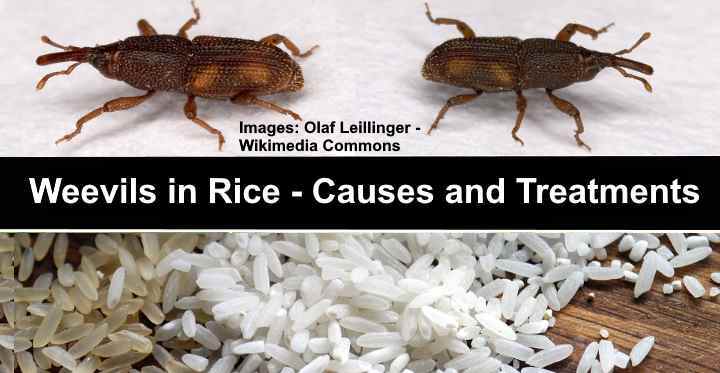
Finding weevils in a bag of rice can be an unsettling experience. The tiny reddish-brown beetles can infest rice, stored grains, pasta, cake mixes, and other cereal products. What’s worse, the small bugs can lay hundreds of microscopic eggs in grain kernels that hatch into larvae and then become adult weevils. Because of their minuscule size, rice weevils are difficult to spot in grain products.
Rice weevils look like tiny black dots contrasting with white rice grains. So, you may be wondering how the small bugs got into your packet of rice. But more importantly, how can you get rid of weevils in rice? And what can you do to prevent these small house bugs from infesting your pantry staples? Please read on to find the answers to these questions and more.
What Is a Rice Weevil (Sitophilus oryzae)?
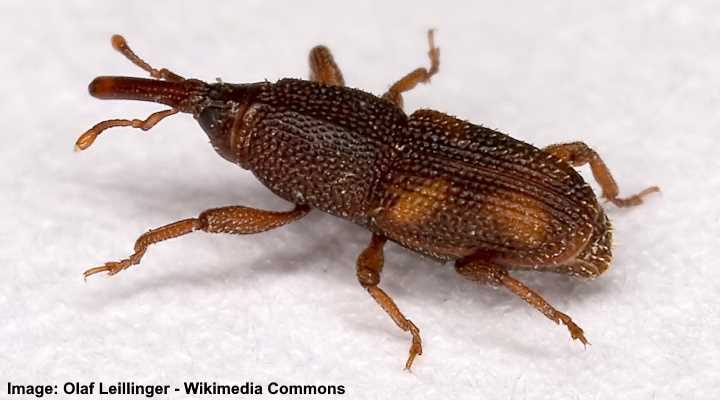
The rice weevil is a type of small brown beetle identified by its elongated snout
A rice weevil is a small type of brown beetle, identified by its long slender snout, black to brown oval body, and dotted lines on its wing covers. Rice weevil adults measure between 0.10” and 0.16” (2.5 – 4 mm) long. Additionally, the dark brown beetles have small elbowed antennae and six legs.
Rice weevils are similar to maize weevils (Sitophilus zeamais), also called the greater rice weevil. However, rice weevils are smaller in size and have four distinctive orange spots on their wing covers.
Unlike most other weevils that infest pantries, rice weevils have wings and can fly. Unfortunately, this means that adult weevils can easily contaminate nearby food products if they are stored in open or paper bags.
Rice weevils are among some of the most prolific pantry pests you can find. The pesky bugs don’t just infest rice. They will live in wheat, corn, maize, nuts, dried cereals, and other dry food products.
How to Identify Weevils in Rice

Identifying stored food product pests in rice and other grains is challenging. The tiny weevils in rice can go undetected for several months. However, you should regularly check rice and other grain products for small beetles that are black or brown in color. The tiny pantry bugs are about half the size of a long grain of rice.
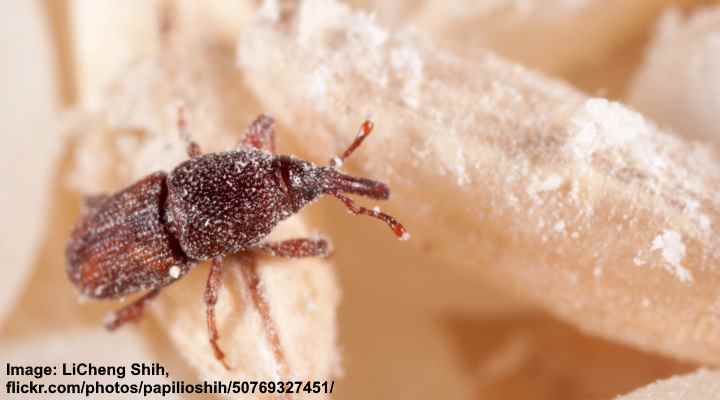
Signs of Rice Weevil Infestation
It’s possible to spot adult rice weevils by tell-tale signs of their activity. Here are a few ways to tell if adult beetles or other pantry pests are in your packets of flour, rice, and whole grain kernel foods.
Silky webbing in packets of rice
Rice weevil larvae spin sticky webs that you may notice dangling inside packets of rice. The silky strands tend to have small clumps of broken rice on them. You will often notice the fine cobwebs before you spot the annoying bugs.
It’s good to note that silky cobweb strands in stored grain packets could indicate other pantry bug infestations. Therefore, whether they are weevils, Indian meal moths, red flour beetles, grain borers, or flat grain beetles, you should discard the infested food products.
Small bugs crawling in rice
Sometimes you may spot small brown bugs crawling in rice. Identifying weevils in rice is easier in white rice, as their dark brown bodies contrast with the white grains. However, the brown critters will be harder to spot in packets of wholegrain rice.
Black sawdust-like droppings
Frass or rice weevil poop looks like fine powder or small black dots in rice. Seeing black spots typically signifies a heavy infestation where many rice weevils live.
Rice weevil carcasses
You may find dead weevil bodies in packets of rice you haven’t opened for a while. Rice weevils can live for four to five months, during which time female weevils can lay up to 400 eggs. Therefore, infestations can happen rapidly in packets of rice, grains, or flour.
Musty odor is a sign of heavy rice weevil infestation
The beetle poop may also emit a musty stench, indicating extensive weevil activity. Additionally, dead weevil carcasses can emit an “off” smell. This is usually more noticeable when opening a packet of infested rice or other stored grain products.
Noticing small flying insects
You may notice tiny brown flies in pantry spaces or kitchen cupboards. These tiny flying bugs are so small that you may mistake them for fruit flies or fungus gnats. However, small flies in a dark, enclosed space will likely be flying rice weevils.
What Do Rice Weevils Eat?
Rice weevils feed on any kind of dried grain products. As their name suggests, they commonly eat rice, where the female weevils lay eggs in rice grain kernels. However, rice weevils also feed on grains like corn, wheat, cereals, and dried beans. And they are attracted to pet food.
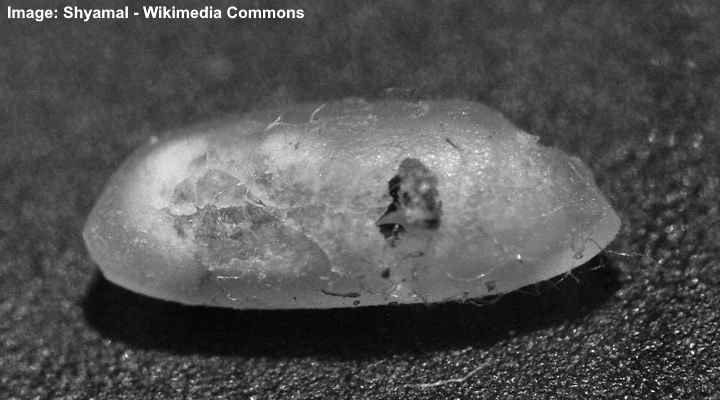
A grain of rice with rice weevil
How Do Weevils Get Into Rice
Weevils typically get into packets of rice in the processing plant or crop kernels before they are harvested. The female beetle deposits a single egg in a grain kernel and then seals the hole with a waxy plug. In cold weather, the pupal and larval stages can last several months.
Therefore, most people inadvertently bring rice weevils in infested grain packets into their homes. If a single grain of rice has a larva inside, it will develop into an adult before boring out of the rice grain.
Rice Weevil Life Cycle
The life cycle of rice weevils takes around 32 days and starts as an egg deposited in a grain kernel. The eggs hatch after three days, and the larva feeds on the grain kernel for around 18 days, making it hollow. The pupal stage lasts six days, and the adult exits the grain after three or four days.
Adult female rice and grain weevils have strong mandibles, allowing them to chew a hole in a kernel of grain. Typically, only a single egg is placed in each kernel. However, sometimes, the female may deposit up to four eggs.
In cold weather, the life cycle of rice weevils is much longer, extending to several months. Typically, an adult rice weevil lives for up to five months. However, they can live for seven months in rice or other grain products in cooler temperatures.
Rice Weevil Damage
Rice weevils damage grains and cereals in several ways. First, the tiny brown critters hollow out grains, making them useless. Second, weevils leave droppings in foodstuffs which can give grains and rice a stale smell, and in extreme cases, mold can grow.
Therefore, soaking pulses and grains before cooking is a good way to check for weevil infestations. Healthy peas, beans, and other grains will sink, while grains where a weevil has been living will float.
Are Rice Weevils Harmful?
Despite being a pesky nuisance in pantries, rice weevils are not harmful to humans. The tiny brown kitchen bugs don’t bite, sting, or carry diseases. Additionally, pantry weevils don’t chew on furniture, house structures, or other similar items. The only harm they cause is to seeds, grains, pulses, and other dried foods.
Is Rice With Weevils Safe to Eat?
Rice weevils do not threaten food safety. The boiling process will kill any live weevils and bugs, making the food safe to eat. Although it is safe to eat rice with weevils, most people squirm at the idea. Therefore, you can check for weevils in rice when washing it before cooking. If you spot tiny brown insects, simply remove them before cooking.
How to Get Rid of Weevils in Rice
Getting rid of weevils in rice can be tricky, but it’s certainly doable. Eradicating rice weevils and other grain pests requires removing infested products, cleaning the pantry, and preventing further infestations. You can do this by storing dry foods in airtight glass or plastic containers.
It’s also good to periodically check your pantry or kitchen cupboards for signs of weevil activity.
Here are some effective ways to eliminate rice weevils from your pantry:
Remove Infested Food Products
The first step in dealing with a rice weevil infestation is to toss out infected dried food products. Finding many weevils and larvae in a packet of rice probably indicates the infestation source. However, checking other packets of grains, cereals, and flour in your pantry is good.
Throwing out infected food helps prevent weevils in other food packets from reproducing and contaminating products. Usually, noticing small clumps of food dangling from packaging is a good sign of weevil, moth, and beetle activity.
Remember to dispose of infested rice packets in sealable plastic bags in the outdoor trash can where pesky bugs cannot escape.
Freeze Rice and Other Grains
Freezing new, unopened packets of rice for three to seven days at 0°F (-18°C) should kill any bugs, larvae, and eggs in food products. After freezing, check the rice carefully to look for small brown beetles. Then, you can transfer the rice or other grain product to a weevil-proof container.
Here are a few things to remember when freezing rice to kill weevils:
- Transfer rice to a sealable freezer bag before freezing it.
- After freezing it, spread the rice out on a clean baking tray to inspect for signs of weevils.
- It’s possible that freezing doesn’t kill eggs. Therefore, be in the habit of checking rice for weevils before cooking.
Vacuum Pantry Shelves to Get Rid of Rice Weevils
To eliminate rice weevils from a pantry, thoroughly clean all shelves and work surfaces. First, use a vacuum cleaner to get into nooks and crannies to ensure you suck up all eggs, larvae, dead weevils, and living pantry bugs. Then, wipe down shelves with hot soapy water to clean leftover debris.
Homemade Rice Weevil Spray
You can make a DIY bug spray by mixing equal parts of white vinegar and water. Spray the vinegar solution on clean shelves and leave it to dry naturally. The acidic qualities of vinegar can kill any remaining weevils, and its pungent smell acts as a repellent.
It’s good to note that using a vinegar spray to clean food surfaces has an antimicrobial effect. Scientific studies have shown apple cider vinegar (ACV) has antimicrobial properties. In addition, tests suggest that ACV can help destroy food pathogens like E. coli.
How to Prevent Rice Weevils
Preventing rice weevils from getting into packets of rice in the first place is the best way to deal with them. So here are some tips on how to avoid pantry bug infestations:
Store Rice and Other Grains in Airtight Containers
You can prevent rice weevils from getting to food sources by storing rice and other cereals in glass or plastic sealed containers. Remember, weevils and beetles can easily chew through paper, cardboard, and thin plastic packaging. So putting dry foodstuffs in airtight containers will stop the critters from wreaking havoc in your pantry.
Use Natural Rice Weevil Repellents
Strong aromas can be effective weevil repellents to keep them away from rice, grains, and dried pulses. Some evidence suggests that bay leaves are the best home remedy for repelling rice weevils. However, you could also try putting cloves, garlic, or crushed peppercorns in your kitchen cupboards.
For example, some research suggests that compounds in bay leaves have a repelling action on Sitophilus oryzae (rice weevils). In addition, the study found other effective weevil-repelling spices that were effective repellents, including anise, cinnamon, and clove.
Inspect Food Before Storing in Your Kitchen
Prevent rice weevils from invading your pantry by inspecting dried food products before putting them in your cupboards. Rice weevils rarely fly into homes through open windows. Instead, they usually get into homes hidden in packets of flour, rice, pasta, and other stored dry food products.
First, check for silky webs inside food packaging. And if in doubt about weevil contamination in rice, freeze the rice for several days, then store it in a glass jar with a lid or an airtight plastic container.
Store Rice and Other Dry Foods in a Cool Dry Place
If rice weevil activity is an issue in your kitchen, try storing rice and other grains in the refrigerator. Rice weevils become inactive in temperatures lower than 55°F (13°C). Therefore any weevils, larvae, or eggs in the product will not reproduce and infest your rice products.
Don’t Buy Rice in Bulk to Avoid Rice Weevil Infestations
Another way to prevent rice weevils from becoming pests in your pantry is to purchase smaller quantities of rice. Some pest experts suggest only buying enough rice, oats, flour, and similar products for a month’s supply.
Because the life cycle of rice weevils is around 30 days, eggs or larvae in grains will have little chance of pupating and turning into adult beetles.
Don’t Leave Pet Food Out Overnight
Rice and grain weevils can also infest dried pet food and kibble. Therefore, only leave dog or cat food out for as long as necessary. Otherwise, it won’t only be your pet feeding in the bowl; you may also have a family of weevils there.
It’s good to note that all types of grains and seeds attract rice weevils. Therefore, store bird seed, dog kibble, and cat treats in airtight containers.
Thankfully, rice weevils are harmless to pets. And there is nothing to worry about if your furry friend consumes dried pet food with weevils, beetles, or other grain pests.
Other Types of Weevils in Rice
Maize Weevil (Sitophilus zeamais)
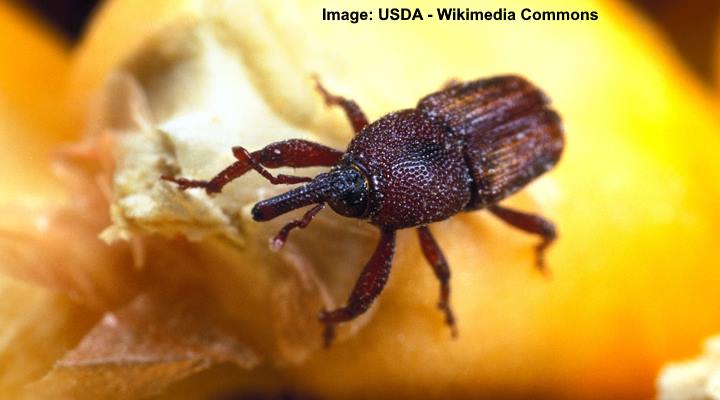
Maize weevil (Sitophilus zeamais)
The maize weevil resembles a rice weevil, only that it is bigger. It has a dark brown, oval body with lines of pits along its wing covers. Additionally, the maize weevil has dull orange spots on its back. The maize weevil measures 0.09” to 0.19” (2.3 – 5 mm) long.
Granary Weevil (Sitophilus granarius)
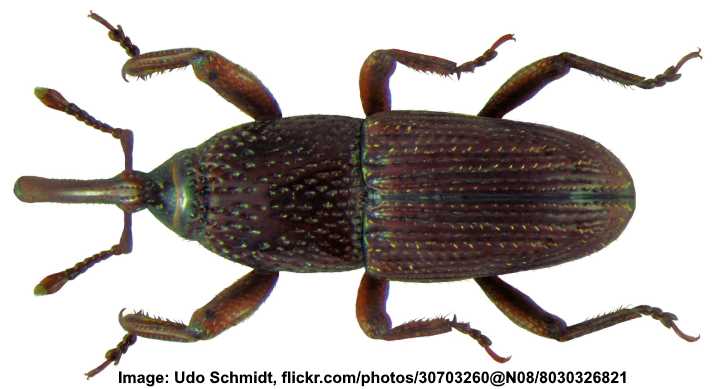
Granary weevil (Sitophilus granarius)
The granary weevil is a small reddish-brown beetle with a characteristic slender snout. Also called a grain weevil or wheat weevil, the pesky pantry bug measures 0.12” to 0.20” (3 – 5 mm) long. Unlike the rice weevil, the granary weevil doesn’t have distinguishing orange spots on its wing covers.
Bean Weevil (Acanthoscelides obtectus)
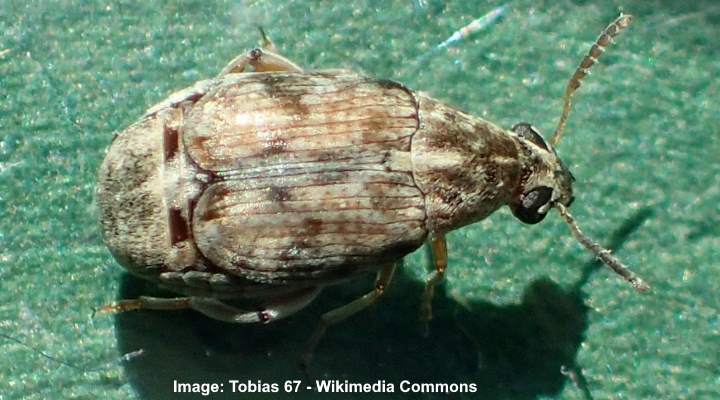
The bean weevil (Acanthoscelides obtectus)
The bean weevil is a small type of beetle with a tear-shaped body, brown mottled patterns, and two antennae. A distinguishing feature of the bean weevil is its short wing covers that don’t cover the abdomen entirely. Also, it lacks the characteristic snout of most weevil species.
The bean weevil measures 0.078” to 0.2” (2 – 5 mm) long. As its name suggests, this pesky pantry bug typically infests dried pulses, peas, and beans.
Related articles:
- Small House Bugs – Identification Guide
- Types of Pantry Bugs – Identification and Treatment
- Small Brown Bugs – Identification Guide
